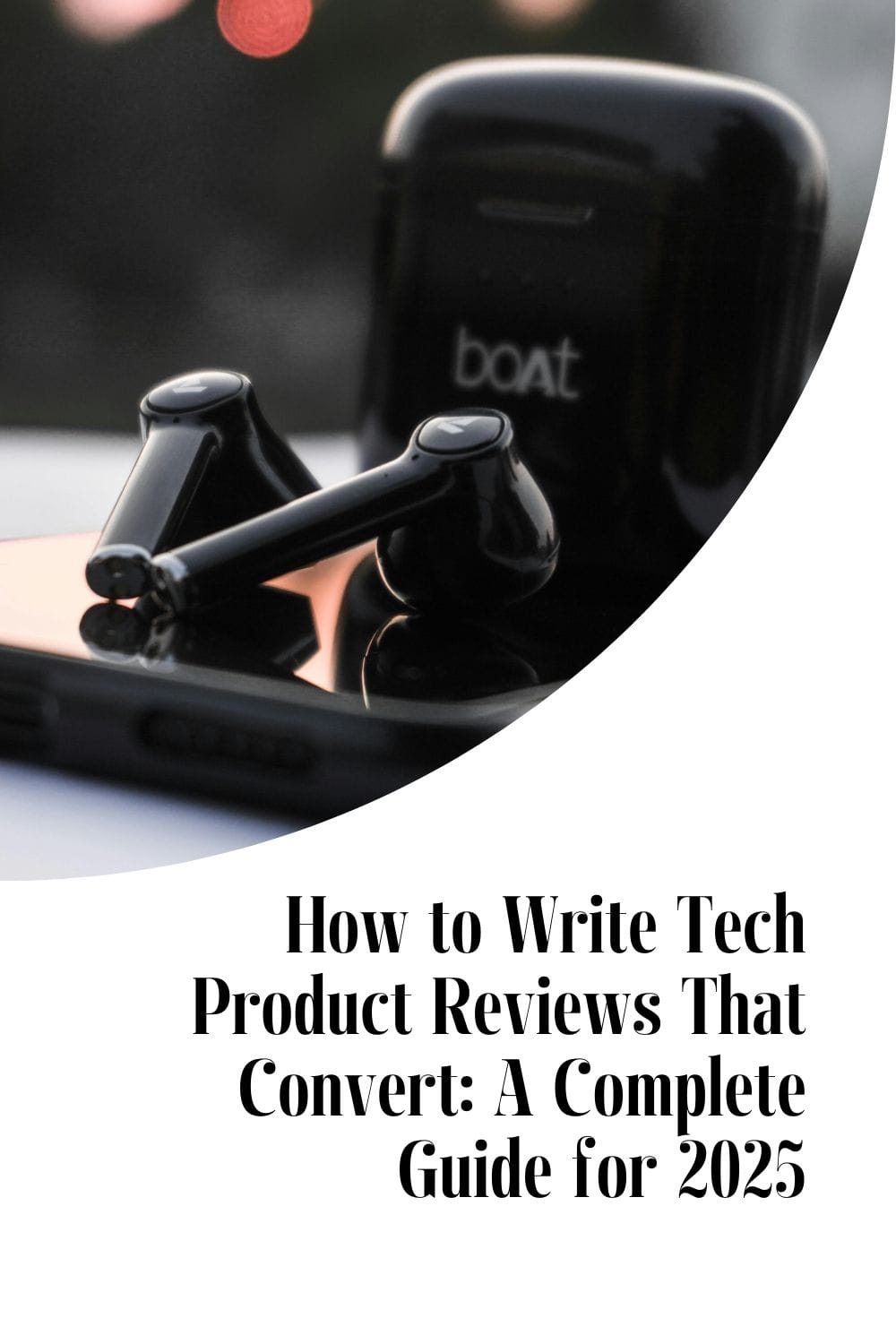The way people buy technology has changed forever. A decade ago, someone thinking of buying a new laptop might have walked into a store, asked the sales associate a few questions, and walked out with a device. Today, that same buyer probably spends hours watching unboxing videos, scrolling through Reddit threads, and — most importantly — reading reviews before clicking “add to cart.”
Reviews are no longer an afterthought in the buyer’s journey; they are the centerpiece. And in the technology sector, where products are often complex, expensive, and fast-evolving, a review is more than a personal opinion. It’s a trusted guide that can either persuade someone to make a purchase or push them away entirely.
If you’re a blogger, affiliate marketer, or content creator, learning how to craft product reviews that don’t just inform but actually convert readers into buyers is one of the most valuable skills you can develop. Writing in the tech space makes this both more challenging and more rewarding, because readers are actively looking for guidance — but they won’t settle for vague commentary or empty hype. They want honesty, clarity, and actionable insights.
This guide will show you how to write tech product reviews that convert, blending clarity with storytelling, balancing objectivity with persuasion, and layering in SEO strategies so your reviews are discovered by the right audience at the right time.
Why Writing Tech Reviews Is a Unique Challenge
Writing about beauty products, kitchen appliances, or fitness gear follows certain patterns. You talk about usability, aesthetics, and price. Tech reviews, on the other hand, add a few layers of complexity that make them stand apart.
First, there’s the issue of technical specifications. A smartphone might boast a Snapdragon processor, a certain number of gigahertz, RAM in DDR5 format, or screen refresh rates. These numbers can overwhelm a casual reader but are essential for enthusiasts who use them to gauge performance. The challenge is translating specs into everyday benefits without losing credibility.
Second, technology products age quickly. A laptop hailed as “the best of 2024” may feel outdated by early 2026. Unlike a blender or a pair of shoes, tech buyers are acutely aware of this timeline. They want to know whether a product is worth its price now and how long it will stay relevant.
Third, tech purchases are often high-stakes decisions. A gaming PC, flagship smartphone, or professional-grade camera can cost hundreds or even thousands of dollars. Buyers don’t just want to know if the product works; they want reassurance that they won’t regret the investment.
And finally, the audience itself is diverse. On one end, you have hardcore enthusiasts who want benchmark tests and side-by-side comparisons. On the other, you have casual buyers who just want to know if the laptop can run Zoom smoothly. Writing a review that appeals to both groups requires balance, clarity, and empathy.
Understanding Your Audience Before You Write
Every successful product review begins with a deep understanding of the intended audience. If you don’t know who you’re writing for, your review may end up sounding too technical for beginners or too shallow for experts.
Imagine two different readers. The first is a college student searching for a budget laptop that can handle essays, streaming, and occasional gaming. The second is a video editor who needs a powerful machine with a high-resolution display and plenty of storage. Both are shopping for laptops, but their priorities are wildly different.
Before you draft your review, ask yourself: Who am I speaking to? Are they casual buyers, professionals, gamers, or tech enthusiasts? By narrowing down your audience, you can tailor your tone and level of detail. A review meant for professionals should dive deeper into productivity features, while one aimed at casual consumers should focus on ease of use and value.
Structuring a Review for Maximum Conversion
A good review doesn’t simply list specs and impressions in random order. It follows a structure that leads the reader on a journey from curiosity to confidence, ending with a clear sense of whether or not they should buy.
Start with an introduction that captures attention. Instead of immediately listing features, frame the product as a solution to a problem. For example: “The Samsung Galaxy Z Fold 5 isn’t just another smartphone. It’s marketed as a device that can replace your tablet and laptop. But does it really live up to this promise?” This sets the stage for the reader to keep scrolling.
Follow this with a quick verdict or summary. Many readers skim articles and want to know the bottom line right away. A short paragraph summarizing the pros, cons, and who the product is best suited for is invaluable. Think of it as your “TL;DR” moment.
Once the hook is set, move into a product overview. Give readers a sense of what the product is, its market positioning, and its intended audience. From there, dive into the features and specifications, but avoid overwhelming your audience. Instead of dumping numbers, explain what they mean. Don’t just say the phone has a 120Hz refresh rate; explain that scrolling feels smoother and gaming becomes more immersive.
The heart of your review should be your hands-on experience. This is where your personal testing and storytelling shine. Share anecdotes — how the laptop handled a busy workday with 30 Chrome tabs open, or how the noise-canceling headphones performed on a crowded train. These real-life scenarios resonate more than abstract benchmarks.
Comparisons are another critical piece. Most readers aren’t deciding whether to buy a product; they’re deciding between this product and another. By directly comparing the item to its closest competitors, you’re helping the reader visualize their choice more clearly.
Finally, wrap up with a conclusion that doesn’t just summarize but guides. Tell readers who should buy this product, who might want to wait for a price drop, and who should consider alternatives. End with a clear call to action, pointing them toward where they can purchase or read related reviews.
Translating Specs Into Benefits
One of the biggest mistakes new reviewers make is copying and pasting specifications from the manufacturer’s website. While specs are important, readers want to know what those specs mean for them in practice.
Take RAM as an example. Writing “This laptop comes with 16GB of DDR5 RAM” might impress enthusiasts, but for the average buyer it’s just numbers. A more effective description would be: “With 16GB of the latest DDR5 RAM, this laptop lets you run multiple demanding applications at once — from editing videos to streaming music — without slowing down.”
By translating specifications into tangible benefits, you make the review accessible to beginners while still useful for experts. The key is to always ask: Why should the reader care about this feature?
The Power of Storytelling in Reviews
Storytelling isn’t just for novels or advertising campaigns. It’s a tool that can make your review memorable and persuasive. Instead of presenting dry information, weave in personal anecdotes and scenarios.
For instance, if you’re reviewing noise-canceling headphones, don’t just say “the ANC works well.” Share a story: “On a flight from New York to Los Angeles, I wore these headphones for six hours straight. The roar of the engine faded into silence, and even the crying baby two rows behind me became a distant hum.” That single story paints a vivid picture that specs alone never could.
Readers connect with stories because they allow them to imagine themselves using the product. The more you help readers see how the product fits into their lives, the more likely they are to convert.
Balancing Honesty and Persuasion
If your review sounds like a sales brochure, readers will tune out. If it’s overly negative, they may never return to your site. The key is balance.
Be honest about the product’s shortcomings. If a laptop gets hot during heavy gaming, mention it. But frame it in context: “The laptop does run hot after a few hours of gaming, but a cooling pad easily fixes this.” Honesty builds credibility, and credibility builds trust.
At the same time, don’t shy away from persuasion. Highlight strengths in a way that gets readers excited. Instead of writing “The display is good,” try “The OLED display makes everything pop with vibrant colors, whether you’re streaming Netflix or editing photos.”
This mix of transparency and enthusiasm positions you as a trustworthy reviewer — someone readers can rely on to guide their purchase decisions.
Making Reviews SEO-Friendly Without Sacrificing Flow
Even the best review won’t convert if no one reads it. That’s where SEO comes in. The trick is to optimize for search engines without breaking the natural flow of your writing.
Start by researching keywords. Think about what potential buyers are searching for: “iPhone 15 Pro review,” “best laptops for video editing,” or “Dell XPS 15 vs MacBook Pro.” Sprinkle these keywords naturally into your headings and text. Avoid keyword stuffing — it hurts readability and search rankings.
Use long-tail variations as well. Instead of repeating “Dell XPS 15 review” ten times, include phrases like “how the Dell XPS 15 performs for creators” or “Dell XPS 15 battery life test.” These capture niche searches with high intent.
Formatting also matters. Use descriptive headings, include alt text for images, and add internal links to related reviews. If you can, implement structured data like pros-and-cons schema to increase your chances of appearing in rich snippets on Google.
The goal is simple: make your review easy for readers to find, easy to skim, and valuable enough that they stick around.
The Role of Visuals in Tech Reviews
Words are powerful, but in tech reviews, visuals do a lot of heavy lifting. High-quality photos show readers exactly what the product looks like in real life, beyond glossy promotional images. A well-lit photo of a laptop’s keyboard or a side profile of a phone reveals details buyers care about.
Comparison charts can also be game changers. Imagine a table that places the Dell XPS 15 side by side with the MacBook Pro and HP Spectre, highlighting differences in weight, battery life, and price. That single chart saves readers time and reinforces your authority.
Videos and GIFs add another dimension. A short clip showing how fast an app launches or how smooth a foldable phone’s hinge operates can often say more than a thousand words. These visual elements make your review engaging, trustworthy, and shareable.
Building Trust Through Transparency
Affiliate marketing has transformed the review landscape. Many tech reviewers earn commissions when readers purchase through their links. This is perfectly acceptable, but transparency is critical. Readers respect honesty, and disclosing affiliate relationships ensures long-term trust.
A simple disclaimer at the start or end of the review works: “This article contains affiliate links. If you purchase through them, I may earn a commission at no additional cost to you. I only recommend products I genuinely believe in.”
By being upfront, you demonstrate integrity, which is one of the strongest factors in building a loyal audience.
Turning Readers Into Buyers With Calls to Action
A review without a clear call to action is like a movie without an ending. Once you’ve built interest and trust, guide your reader toward the next step.
Your call to action should feel natural and aligned with the review’s tone. Instead of shouting “Buy Now!” use language that continues the conversation. For example: “If you’re ready to future-proof your workflow, check today’s best price on Amazon.” This subtle but persuasive approach nudges readers forward without breaking their trust.
Mistakes That Undermine Tech Reviews
Even skilled writers can make errors that reduce the effectiveness of a review. One common mistake is leaning too heavily on jargon, which alienates casual readers. Another is ignoring real-world usability in favor of synthetic benchmarks. While benchmarks have their place, most buyers care more about whether the laptop can last through a workday or whether the smartphone’s camera captures sharp low-light shots.
Another pitfall is overhyping products. If you exaggerate benefits and downplay flaws, readers will sense the bias and may not return to your site. Similarly, failing to update reviews as products evolve or competitors launch can make your content feel stale.
Finally, be mindful of readability. A giant wall of text without headings, visuals, or clear sections will lose even the most interested reader. Reviews should be approachable and engaging from start to finish.
Going Beyond the Basics: Advanced Review Techniques
If you want to elevate your reviews beyond the ordinary, consider adopting more advanced approaches. Running benchmark tests, for example, adds credibility for enthusiasts who want hard numbers. Long-term reviews are another powerful tool. Updating your article after six months with insights about durability, battery degradation, or software updates makes your review stand out.
Comparison articles are particularly effective at driving conversions. When a reader searches “iPad Pro vs Surface Pro,” they are usually on the brink of a purchase. By directly comparing features and recommending the best choice for specific users, you provide exactly the clarity they need.
Community input can also enrich your reviews. Incorporating quotes or insights from user forums, polls, or your own audience makes the review feel more collaborative and well-rounded.
Case Study: Why Some Reviews Dominate the Market
If you look at successful tech reviewers, you’ll notice common patterns. Creators like Marques Brownlee (MKBHD) combine stunning visuals with accessible explanations, delivering both depth and clarity. Outlets like The Verge structure reviews with verdicts, pros-and-cons summaries, and multimedia that make them both informative and entertaining.
Smaller bloggers succeed by focusing on niches the giants overlook. Instead of reviewing every flagship smartphone, they might target “best laptops under $500 for students” or “budget Android phones with long battery life.” By owning these niches, they capture audiences with high purchase intent.
The formula is clear: a balance of authority, clarity, storytelling, SEO, and visuals creates reviews that not only attract readers but also drive conversions.
Conclusion: Reviews That Build Trust and Drive Sales
Writing product reviews in the tech world is not about throwing specs at the reader or hyping up the latest gadget. It’s about guiding people through a decision-making process that feels overwhelming without expert input.
The most effective reviews are built on a foundation of clarity, honesty, and empathy. They explain specs in plain language, share personal experiences through storytelling, balance enthusiasm with fairness, and wrap everything in a structure that’s easy to follow. Add in SEO best practices, compelling visuals, and transparent affiliate disclosure, and you have the blueprint for reviews that both rank and convert.
At the heart of it all lies trust. When readers trust you to give them clear, honest, and helpful guidance, they’re far more likely to take your recommendations seriously — and act on them. Whether you’re writing about a flagship smartphone, a budget-friendly laptop, or a pair of wireless earbuds, the principles remain the same: connect with your audience, simplify complexity, and help them make decisions with confidence.
In a crowded digital landscape, the reviewers who master these skills will not only influence purchases but also build loyal audiences who return again and again. That’s the real power of writing product reviews that convert.






